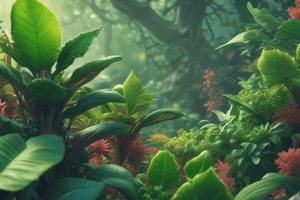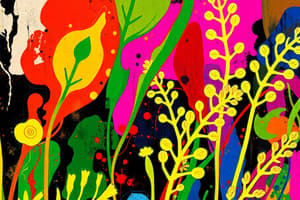Podcast
Questions and Answers
What is the primary function of the vascular tissues in ferns?
What is the primary function of the vascular tissues in ferns?
- To transport water and nutrients throughout the plant. (correct)
- To aid in photosynthesis.
- To provide structural support for the fronds.
- To store food reserves for the plant.
Which of the following is NOT a characteristic of ferns?
Which of the following is NOT a characteristic of ferns?
- They often have creeping or underground stems called rhizomes.
- They can thrive in areas with little light.
- They have large leaves called fronds.
- They are non-vascular plants. (correct)
Which of the following is the primary way in which ferns reproduce?
Which of the following is the primary way in which ferns reproduce?
- By producing spores. (correct)
- By flowering and pollination.
- By producing seeds.
- By vegetative propagation.
What is the significance of rhizomes in ferns?
What is the significance of rhizomes in ferns?
Which of the following is a key adaptation that allows ferns to thrive in areas with little light?
Which of the following is a key adaptation that allows ferns to thrive in areas with little light?
Which of the following statements can be inferred from the provided information about ferns?
Which of the following statements can be inferred from the provided information about ferns?
Based on the information provided, which of the following is a likely reason for the abundance of ferns in wet habitats?
Based on the information provided, which of the following is a likely reason for the abundance of ferns in wet habitats?
Which of the following statements, if true, would further support the claim that ferns are most abundant in wet habitats?
Which of the following statements, if true, would further support the claim that ferns are most abundant in wet habitats?
Which of the following is a likely explanation for the statement "The large plants easily recognized as ferns are actually the diploid sporophyte phase of the fern life cycle"?
Which of the following is a likely explanation for the statement "The large plants easily recognized as ferns are actually the diploid sporophyte phase of the fern life cycle"?
What type of life cycle do ferns exhibit?
What type of life cycle do ferns exhibit?
Flashcards
Vascular Tissues
Vascular Tissues
Tissues in plants that transport water and nutrients.
Rhizomes
Rhizomes
Creeping or underground stems that store nutrients and enable growth.
Fronds
Fronds
Large leaves of ferns that are often divided into smaller leaflets.
Light Tolerance
Light Tolerance
Signup and view all the flashcards
True Roots
True Roots
Signup and view all the flashcards
Wet Habitats
Wet Habitats
Signup and view all the flashcards
Fern Life Cycle
Fern Life Cycle
Signup and view all the flashcards
Sporophyte Phase
Sporophyte Phase
Signup and view all the flashcards
Diploid
Diploid
Signup and view all the flashcards
Life Cycle Stages
Life Cycle Stages
Signup and view all the flashcards
Study Notes
Chapter 22: Plants - Final Exam Highlight
- Plants require sunlight for photosynthesis
- Gas exchange is needed by plants for photosynthesis and respiration
- Water and minerals are crucial for nutrient transport and structural support
- Early plants were aquatic, specifically green algae
- Plants adapted to land about 472 million years ago, developing structures for water retention and reproduction
- All plants are eukaryotic, have cellulose cell walls, and perform photosynthesis (using chlorophyll a and b)
- Key evolutionary traits include embryo protection, water-conducting tissues, seeds, and flowers
- Plants alternate between haploid (N) gametophyte and diploid (2N) sporophyte phases
- Evolution favored a reduced gametophyte phase and an expanded sporophyte phase
Lesson 2: Plant Diversity
- Green Algae: Aquatic, mostly unicellular or colonial, reproduce both sexually and asexually.
- Bryophytes (Mosses and Relatives): Lack vascular tissue, remain small, and need water for fertilization; gametophyte is dominant.
- Ferns and Seedless Vascular Plants: Vascular plants (tracheophytes) with tracheids in xylem (water transport tissue) and phloem ( nutrient transport).
Lesson 3: Flowers, Fruits, and Seeds
- Angiosperms: Defined by flowers and fruits protecting seeds, classified into monocots and dicots
- Flower Structure: Includes sepals, petals, stamens (male), and carpels (female); petals attract pollinators
- Pollination and Fertilization: Pollen transfer to stigma, leading to fertilization via pollen tubes creating a zygote and endosperm
- Fruits and Seed Dispersal: Fruits form from ovary walls, protecting seeds, dispersing via animals, wind, or water
- Vegetative Reproduction: Asexual reproduction leads to genetically identical offspring (no seeds or gametes)
Chapter 23: Plant Structure and Function - Overview of Plant Structure
- Roots: Anchor plant, absorb water and nutrients, types include taproots and fibrous roots
- Stems: Support plant, transport substances (xylem and phloem) between roots and leaves
- Leaves: Photosynthesis, containing stomata for gas exchange
Chapter 24: Animal Evolution, Diversity, and Behaviour - Animal Evolution
- Origins: Animals evolved from colonial protists over 600 million years ago.
- Body Plans: Symmetry (radial vs. bilateral); layers (ectoderm, mesoderm, endoderm); Body cavity (coelom)
- Animal Diversity:
- Invertebrates: Include animals lacking a vertebral column (sponges, cnidarians, mollusks, arthropods)
- Vertebrates: Include animals with a backbone (fish, amphibians, reptiles, birds, mammals)
- Primate Evolution: Characteristics include flexible hands, forward-facing eyes, large brains, with primate groups including prosimians, anthropoids
- Social Interactions: Solitary vs. group living; forms of communication; cooperation and altruism.
Studying That Suits You
Use AI to generate personalized quizzes and flashcards to suit your learning preferences.





